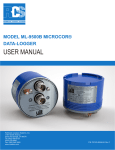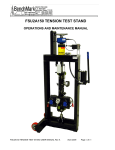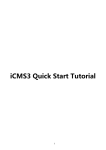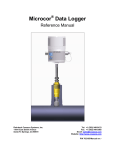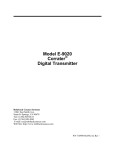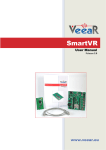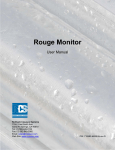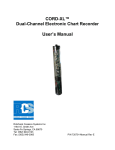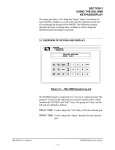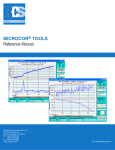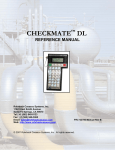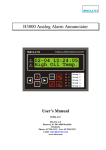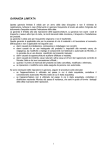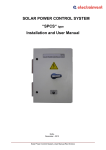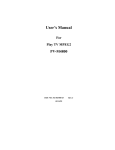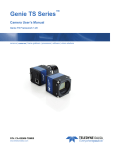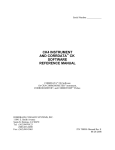Download MODEL MT-9485A MICROCOR® TRANSMITTER User Manual
Transcript
MODEL MT-9485A MICROCOR® TRANSMITTER User Manual Rohrback Cosasco Systems, Inc. 11841 Smith Avenue Santa Fe Springs, CA 90670 Tel: (562) 949-0123 (800) 635-6898 Fax: (562) 949-3065 www.cosasco.com P/N:702200-Manualrev C Microcor® is a registered trademark of Rohrback Cosasco Systems, Inc. Windows® is a trademark of Microsoft Corporation. No part of this manual may be reproduced or transmitted in any form or by any means, electronic or mechanical, including photocopying and recording, for any purpose, without the express written permission of Rohrback Cosasco Systems, Inc. Model MT-9485A Microcor® Transmitter Table of Contents Chapter 1 Introduction ............................................................................1 Chapter 2 Specification ...........................................................................3 Chapter 3 Installation ..............................................................................5 Chapter 4 Operation ...............................................................................15 Appendix A Certifications ........................................................................19 i ii Table of Contents Model MT-9485A Microcor® Transmitter Introduction CHAPTER 1 Note: Your Microcor® Transmitter was carefully tested, inspected and packaged prior to shipment. Before unpacking the instruments, please inspect the packaged materials for shipping damage and retain damaged packaged materials to support any claim against your freight carrier should this become necessary. The Microcor transmitter Model MT-9485A is the latest Model of a new generation of high-resolution digital instruments, which operate with special high-resolution compatible electrical resistance probes. The resolution of the instrument is 18 Bit, or 256 higher than standard electrical resistance measurement instruments. The Model MT-9485A has an automatic gain feature that allows use on the full range of Microcor probe types and alloys. The previous model MT-9485 requires specific gain modules to match the probe type in use (see separate manual for Model MT9485). This increased resolution of the Microcor system greatly improves response to corrosion upsets, and at the same time allows measurements to be made in virtually any environment. The patented technology combines speed of response similar to linear polarization resistance with the universal applicability of electrical resistance measurements. Figure 1 Model MT-9485A Microcor Transmitter 1 2 Introduction The transmitter must be relatively close-coupled to the probe in order to achieve this improved performance. This is achieved by direct connection to the probe through short probe-connecting adapter, or in the case of some retractable probes through a cable of no more than 2 meters (6 feet) length. A typical installation of a Microcor transmitter on a high pressure access fitting with a flexible conduit connection cable is shown in figure 2. The transmitter and the connectors that attach to it are explosion-proof (flame-proof). Warning: Power must be removed before disconnecting either connector on the transmitter if explosive gases are present Figure 2 Microcor transmitter on an Access Fitting The Microcor transmitter may be used for continuous on-line monitoring systems, or in conjunction with a separate battery operated data-logger for autonomous operation. For on-line systems, the 24 VDC power supply and the RS 485 communications allow multi-drop connections between the central corrosion monitoring computer and all of the transmitters. This minimizes cabling costs. Each transmitter has internal DIP switches to set the Identification Number or Address of the transmitter from 0 to 31 for communications over the two-wire RS 485 bus. Model MT-9485A Microcor® Transmitter CHAPTER 2 Specification Transmitter Model MT-9485A • Enclosure NEMA 7 and IP 66/ NEMA 4X • Weight 3.5 lbs (1.6 Kg) • Dimensions 4.5” (115mm) Diameter by 4.25” (108 mm) High including connectors • Power supply 10-32 VDC at the transmitter • Current consumption at 24VDC typical 17 mA Microcor Transmitter Current Consumption 42 37 Typical Current 32 27 22 17 12 7 5 10 15 20 25 30 35 Supply voltage • Communication RS 485 two-wire 2400 Baud, 8 data bits, 1 stop bit, no parity (300 baud when connecting through RS232/485 converter MA-1000) • Proprietary communications protocol (see Appendix B for details) • RS 485 addresses 0 to 31 • Probe element resistance range: 1 to 50 milliohms • Resolution 18 bit (1 part in 262,144) • Ambient temperature range -40C to +70C (-40F to 158F) 3 4 Specification • Hazardous area Certifications: Europe (CENELEC) CE 0539 II 2G DEMKO 03 ATEX 0215219 STD EEx d IIC T6 Tamb= -40C to +70C USA/Canada Class 1 Zone 1A Exd IIC T6 Class 1, Div 2, Groups A, B, C, D when installed in accordance with installation drawing 702106 Tamb= -40C to +70C Model MT-9485A Microcor® Transmitter CHAPTER 3 Installation Microcor transmitters can only be used with Microcor probes. These probes are designated by an “M” in the probe model number. Figure 3 Model M4700 and M4500 Probes Microcor probes are available only in the cylindrical element form, such as the M2500, M3500, M4500 and in the flush element form, such as the M2700, M3700, M4700 in order obtain the high resolution for which the Microcor system is designed. Transmitter Enclosure The Microcor transmitter enclosure is explosion-proof (flame-proof), and is sealed with an O-ring so as to be gas-tight when fully tightened Warning: It is very important to make sure that the transmitter cover is fully tightened down on to the O-ring seal, to avoid in-leakage of water or moist air that may subsequently cause condensation. Water or condensation is likely to cause malfunction of the transmitter and even corrosion of the electronics. A corrosion inhibitor pad is included inside the transmitter for added protection. 5 6 Installation The transmitter cover can be tightened, with the aid of a 2” center by 1/4” pin spanner wrench on the base of the unit and by hand or with a 3/8” square bar or similar on the cover. See Figure 4. The cover of the transmitter can be locked in place with the 1/16” Allen screw. See Figure 5. This is a requirement of the explosionproof (flameproof) enclosure to prevent accidental loosening of the cover. When connecting the transmitter to a probe and power/communications cables in a hazardous area, explosionproof (flameproof) connectors are used as shown in Figure 6. Take care when making these connections not to damage the sealing O rings. A small amount of white grease or silicone grease should be used to lubricate the O rings to assist assembly. Make sure that the connector nuts are fully tightened over the O rings, and that the Allen screws are then locked to prevent loosening. The connections may only be made and unmade in a hazardous area with the power shut off to the system. Take care when disconnecting a cable or probe to make sure that the Allen locking screw has been loosened first. Figure 4 Spanner Wrench Figure 5 Locking Allen Screw Model MT-9485A Microcor® Transmitter Figure 6 Explosionproof Connections The transmitter connects to the probe directly via the probe-connecting adapter. If necessary, a special extension cable of no more than 6 feet (2 meters) may be used between the probe and the transmitter. This may be required on some retractable probe installations where the transmitter on the end of the probe would be subject to too much vibration or too high a temperature. The spanner wrench, Allen Key, and manual CD are included in the Installation Kit (PN 702109) included with every order. 7 8 Installation Transmitter Connections The System connections to the transmitter are as follows: Connector A B Color Black Red Pairs Pair Description 0 VDC Supply 24 VDC Supply C D Green White or Black Pair RS 485 - Tx+ (B) RS 485 - Tx- (A) When multiple transmitters are used on the same RS 485 line, each transmitter must be set to a different electronic address. By the RS 485 standard, up to 32 transmitter/receivers may be used on one RS 485 line. The maximum line length is 4000 feet (1200 meters). For lengths greater than 4000 ft, a repeater must be used. For typical systems with more than 32 transmitters, multiple communication ports are used on the corrosion computer with no more than 32 transmitters on any one com port. The requirements of the standards for use of the Microcor transmitter under its explosion-proof rating (flame-proof) call for the transmitter to grounded (earthed) or bonded to ground. When the transmitter is connected directly to a probe, this bonding is accomplished through the probe body. To ensure good bonding, an 14 to 18 swg grounding wire can be attached to the transmitter at the grounding stud provided and connected to ground (earth) Setting Addresses for RS 485 Multi-drop The transmitters are delivered with addresses already set. This address is marked on the outside of the transmitter as the I/N or Identification Number. These addresses can be used directly if the system is less than 32 transmitters without making any changes. If it is an add-on to an existing system, then the number may have to be changed, in order to avoid any address conflicts with an existing transmitter on the same line. If there are more than 32 transmitters on the system, then no more than 32 can be used on any one communication line. The DIP switch for setting the address and other parameters is on the top circuit board of the transmitter (see figure 6) Model MT-9485A Microcor® Transmitter Figure 6 DIP Switches 9 10 Installation The Transmitter addresses are set by DIP switches 1 to 5 DIP Address ON OFF Address ON OFF Address ON OFF Address ON OFF Address ON OFF Address ON OFF Address ON OFF Address ON OFF 1 2 3 4 5 1 2 3 4 5 0 8 * * * * * * * * * * 1 9 * * * * * * * * * * 2 10 * * * * * * * * * * 3 11 * * * * * * * * * * 4 12 * * * * * * * * * * 5 13 * * * * * * * * * * 6 14 * * * * * * * * * * 7 15 * * * * * * * * * * 1 2 3 4 5 1 16 * * * * * * 17 * * * * * * 18 * * * * * * 19 * * * * * * 20 * * * * * * 21 * * * * * * 22 * * * * * * 23 * * * * * * 2 3 4 24 * * * 25 * * * 26 * * * 27 * * * 28 * * * 29 * * * 30 5 * * * * * 31 * * * * * * * * * The DIP switches 6 and 7 may be OFF or ON on this model. System Wiring Requirements Care is required when installing cabling for connection of an on-line multi-drop system, especially on the 24VDC supply lines to ensure that there is sufficient voltage at each transmitter to drive the electronics. A two pair individually shielded cable is recommended. The gauge of the wire depends on the number of transmitters and the maximum cable length. We do not recommend cables of less than 22 swg. The following calculations are based on a nominal 24VDC supply at the source. The Microcor transmitter and connectors are explosion-proof (flameproof) and meet hazardous area requirements. Flexible or rigid conduits are required to meet North American hazardous area requirements. Flexible conduits are also frequently preferred in order to provide physical protection to the cables, such as shown in figure 2. If cabling is sized correctly for the 24 VDC supply, it will also be more than adequate for the RS 485 communications. Model MT-9485A Microcor® Transmitter Maximum Number of Transmitters with 24 VDC Supply Wire Gauge Cable Length 300 m 600 m 900 m AWG Dia (in) 1000 ft 2000 ft 3000 ft 10 0.120 32 32 32 12 0.096 32 32 32 14 0.076 32 32 22 16 0.060 32 21 14 18 0.048 27 13 9 20 17 8 5 22 10 5 3 1200 m 4000 ft 32 27 17 10 6 4 2 The connection arrangement for multi-drop wiring is shown in figure 7. Warning: RS 485 is a serial, not parallel, connection system. Only short connections are permitted between the RS 485 bus and the transmitter (not more than 50 feet). Splitting the RS 485 bus into two or more spurs of more than 50 feet is not permitted without an RS 485 repeater module. Hazardous Area Tx 1 A B D C A B D C Tx 3 0v +24v TxA TxB 0v +24v +24v +0v Tx 2 0v +24v TxA TxB DC Supply TxA TxB Safe Area A B D C RS 485 Tx+ (A) Tx- (B) Corrosion Computer Junction Box at TX 1 Junction Box at TX 2 Junction Box at TX 3 Multi-drop up to 32 transmitters Figure 7 Multi-drop wiring Conventions of designating Tx+ and Tx-, or A and B for RS 485, commonly vary with different manufacturers. The conventions used here correspond with the EIA standard. Under idle conditions, terminal B is positive with respect to terminal A. The corrosion computer can use a plug-in isolating RS 485 card on a desktop or industrial computer, or an external RS 232 to RS 485 converter (preferably isolating), such as the RCS model MA-1000, on a portable computer (see figure 8). 11 Installation Hazardous Area Tx 1 0v +24v TxA TxB Tx 2 A B D C Corrosion Computer RS 232 300 Baud MA-1000 Conv MP-9000-1 Power Supply A B D C RS 485 2400 Baud 24 VDC Junction Box at TX 1 TxA TxB Safe Area 0v +24v 12 Junction Box at TX 2 Multi-drop up to 32 Transmitters Figure 8 Connection with RS232/485 Converter The terminal blocks in the junction boxes should be 10 way with adjacent pairs linked. This allows a single wire to be inserted into each terminal and provide proper connection. Warning: Two wires should not be connected into one terminal block, as this may cause a high resistance connection or a completely failed connection. This is important particularly in multidrop connection systems to avoid possible system failures. On Microcor systems that use the RCS model MA-1000 converter for RS232 to RS485, and or 24 VDC power supply Model MP-9000-1, completely assembled RCS cables are generally used. Within these cables the same general color coding of wires is generally used, namely Connector A B Color Black Red Pairs Pair Description 0 VDC Supply 24 VDC Supply C D Green White or Black Pair RS 485 - Tx+ (B) RS 485 - Tx- (A) Model MT-9485A Microcor® Transmitter RS 485 Drivers and Converters The transmission is two-wire RS 485 on all units (computer and Microcor transmitters), so that they are all in the receive mode until switched on for a transmission, after which they return to the receive mode. Consequently, only one transmitter at a time must be addressed, and then the response awaited. The transmitter may take up to 1.5 seconds to respond. The Microcor and ICMS3/ Amulet software require that any RS485 cards, RS232 to RS 485 converters, or fiber-optic converters have automatic switching for two-wire RS 485. When using such converters set up the baud rate for 2400 baud, and 8 bit, 1 start bit, 1 stop bit, and no parity if applicable. This sets the time delays associated with the automatic switching. Wrong settings can cause loss of transmissions and their replies. Since the RS 485 bus on the Microcor transmitter operates at 2400 baud, line termination should not be required up to the maximum 4000 ft (1200 metres) that the RS 485 standard allows. At this baud rate all reflections from the end of line should have died before the next transmission character. Bias is normally preset or settable on most converters. The standard settings for the converter will normally operate satisfactorily. Only on long RS485 lines with a large number of transmitters and if line termination resistors are used is it likely that the bias setting may have to be adjusted. See the documentation with that comes with the converter. Checking Operation with Meter Prover A meter prover (see figure 9) is provided with every system to allow testing of the proper operation of the transmitter. This meter prover is very useful to distinguish if a problem is suspected with a probe or transmitter. By simply connecting the meter prover to the transmitter in place of the probe, you can demonstrate if everything other than the probe and its cable and/or adapter is working correctly. The meter prover produces a reading of approximately 50% of full scale. The exact value is not usually particularly important, as it is usually more of a functional test. The actual reading on the transmitter should be within the range of 46% to 54% of full scale. If the meter prover is being used to check the transmitter performance, the actual reading and any changes over time can be reviewed. The repeatability of the reading at constant temperature should be within the range of ± 0.2%. If the temperature of the test probe changes say from 25C to 60C, changes of up to ±0.5% may occur due to temperature effects on the meter prover rather than the transmitter. If the probe is being read on Microcor software and is set to the maximum resolution of 18 bits or 262,144 Probe Life Units (PLU), then the reading would be between 120,586 (46% of full scale) and 141,558 (54% of fullscale). The actual value displayed in this range should not then change by more than ±524 over time when the meter prover is at constant temperature. 13 14 Installation Figure 9 Meter Prover If the probe with a span of 5 mils (such as an F10 probe) is being read in units of mils, the reading should be between 2.3 mils (46% of full range) and 2.7 mils (54% of full range). The reading should not then change by more than ±0.01 mils. Normally, if there is a significant problem with the transmitter the reading will be substantially different from the 50% of full scale. Model MT-9485A Microcor® Transmitter 15 CHAPTER 4 Operation The Microcor transmitter is normally used with a corrosion computer running either Microcor software for simpler systems, or ICMS3/Amulet software for full corrosion management systems. For detailed operation of this software refer to the applicable manual. The Microcor software has four programs as follows: 1. Micrec.exe - For direct on-line recording and display of readings from a single transmitter. 2. Micnet.exe - For direct reading and logging of data from multiple modules. 3. Miclog.exe - For transferring data from a data logger to the PC 4. Micret.exe - For displaying stored data files The ICMS 3/ Amulet software allows continuous on-line monitoring and display of multiple Microcor transmitters, typically up to 256 or more points. This is a full corrosion management system. With both systems, the reading interval may be set, typically at every 5 to 10 minutes. The probe span must be entered to display metal loss in mils, mm or μm. The probe span is half of the probe element thickness. Probe Designation F4 F10 T10 Probe Thickness 4 mils 10 mils 10 mils Probe Span 2 mils 5 mils 5 mils The initial metal loss reading on a new probe will be near to zero. It may even be slightly negative. As the probe corrodes the metal loss will increase in the positive direction. Some noise will be apparent on the signal, and it will vary according to the system in which the probes are operating. In stable temperature systems the noise will be low, typically around 0.02% to 0.04% of probe span. In systems with sudden temperature changes, such a 75C or similar, excursions up to 1% of span may occur for a short while until the temperature and the probe stabilizes again. When a probe reaches above around 80% of probe span, a replacement should be made. Even for a system with low corrosion rates, probes should be removed every 12 to 18 months to ensure that the probe element is clean and intact, and that no penetration under the probe element to the reference has occurred. 16 Operation Troubleshooting If abnormal readings, or an excursion occurs that cannot be explained, the system electronics may be verified by connecting the meter prover in place of the probe and checking that the reading corresponds to 50% of the probe span. See “Checking Operation with Meter Prover” in Chapter 3 Installation. If the meter prover shows the electronics to be operating correctly, then inspect the probe to transmitter connections, and the probe for damage, high resistance, or poor connections. After initial application of power, the transmitter takes approximately one minute to start up during which time it will send the error code -999,999, or -999,996 when its data is requested. On ICMS3 systems these codes will show up as an error message. -999,999 - “Startup Mode”. -999,996 - “Auto Ranging” If there is a probe or probe connection failure an error code -999,998 or -999,997 will be generated. On ICMS3 systems this will display as follows: Code: -999,998 Display: Probe Fault (4) Code: -999,997 Display: Probe Fault (1) Frequently Asked Questions Why is the Metal Loss showing negative on a new probe? The nominal range of the probe is zero to the probe span, such as zero to 5 mils. However, the value on a new probe is zero ± 7.5%. This means that the initial value can be slightly negative. As the probe corrodes it moves in the positive direction and shows positive metal loss values. Why is the Corrosion Rate showing negative? There is always some noise on the metal loss measurement. Corrosion rate is computed from the metal loss data by linear regression(that is the slope of the best straight line through the data used in the regression period) over typically 12 to 48 hours. At low or zero corrosion rates, this small amount of noise may at times produce small negative corrosion rate values. If significant corrosion occurs, this small noise effect will not be noticeable. It is possible to block this negative reading or noise but this can slow down the response to a real corrosion upset when it occurs. Consequently, the greater sensitivity is preferred even if it allows occasional negative corrosion rates, which obviously are not true values. If the negative values are blocked as false values, it can bias calculations on long term low corrosion rates. Model MT-9485A Microcor® Transmitter How do we know when a probe should be replaced? The probe reading of metal loss will commence near zero (±7.5% of span) and will increase as corrosion occurs. When the metal loss reading gets near to 80 to 90% the probe span, it should be replaced. Even if the probe span has not been reached, it is preferable to replace the probe after two years of operation. 17 18 Operation Model MT-9485A Microco® Transmitter ATEX Certification 19 Appendix A 20 ATEX Certification Model MT-9485A Microcor® Transmitter 21 22 ATEX Certification Model MT-9485A Microcor® Transmitter 23



























